Competition between three species of Nothofagus and Pseudotsuga menziesii in young mixed stands planted in the foothill zone of the Andes Mountains, Valdivia/Chile
Main Article Content
Abstract
Forest plantations composed of four species, three from the genus Nothofagus and one of Pseudotsuga menziesii, were evaluated in the X Region of Chile, close to the Maihue Lake. Plantations established in the open and in gaps of no more than 0.04 ha were included in this study. Under both conditions, plots were established on sun exposed slopes (north to west exposures) and shady slopes (east to south exposures), with care taken to make sufficient repetitions. The natural age stages of the plantations were pole stands in the open and thickets in the gaps. The objective of this study was to analyze the development of the young mixed stands of Roble (Nothofagus obliqua), Raulí (N. alpina), Coigüe (N. dombeyi) and Douglas Fir (Pseudotsuga menziesii). This was especially with regard to growth parameters and stem quality, comparing the influence of exposure as well as the plantation in the open and in gaps. Answers as to when and how to undertake the first thinning were expected. Diameter at breast height (DBH) and tree heights of a representative sample were firstly taken and means calculated to make comparisons on a species level. This also took into account the exposure and whether the plantations had been established in the open or in gaps. The second step consisted of studying the competition between trees on an individual scale. In order to realize this objective, 270 trees were selected across all plots and classified with regard to their relative position in comparison to their four closest neighbors. Stem quality was also evaluated. To minimize subjectivity in this process, a system of five quality criteria were developed. In the open, the development of all four species was superior to that in the gaps. However, stem quality was higher in the gaps. In the open, at an age of 10 years, the competitive power of Roble, Raulí and Coigüe was superior to that of the Douglas Fir, whereas in the gaps Douglas Fir, together with Coigüe, attained tree heights superior to that of Roble and Raulí. A study of the competitive status of trees in comparison to their neighbors was included in this study and provides figures of dominant and codominant trees of both good and bad stem forms under all growth conditions. From these figures, recommendations were made about when and how to manage the first tree thinning operation.

